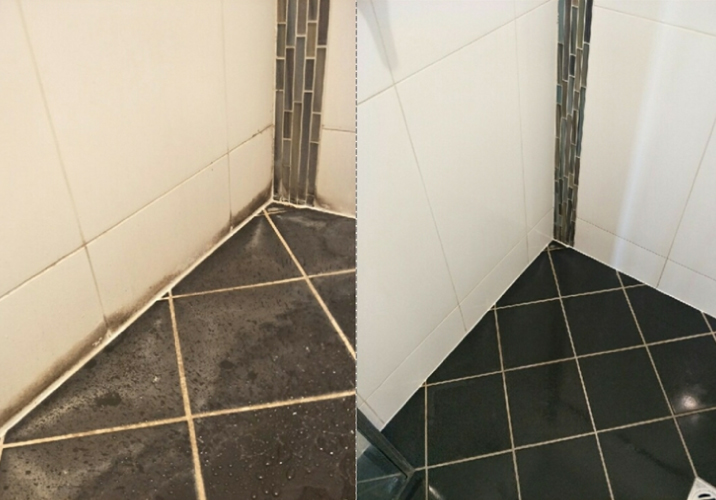
Find a local grout cleaner
- Inspiration /
- Lifestyle /
- Cleaning /
- How to clean grout
How to clean grout
A step by step guide
If you have tiled walls or floors, you will have grout lines across the surface. Grout keeps tiles in place and fills in the gap between every individual piece. Grouting is made from a porous material; so dirt, mould and stains can sink into the lines. These stains make your floor or wall look dirty even after you clean the surfaces well. Tiles are baked and have a glass-like surface that’s easier to clean, so people don’t spend much time trying to clean them.
Grout requires special attention to appear clean, and ordinary floor cleaners just won’t work. You need to put in some time and effort if you want your grouting to appear clean and unstained. Thankfully, the process isn’t that complicated, and you can use homemade natural materials available in your home to clean grout. Grout cleaning is one of the most overlooked services when it comes to house cleaning.

What kind of materials do you need to grout clean?
- Gloves
- A bucket of water
- Baking soda
- Vinegar
- Scrubbing brush (or another grout cleaning tool, like a toothbrush)
- A floor-cleaning mop
- Tile cleaning agent
You can also use bleach or hydrogen peroxide along with baking soda if you want stronger cleaning solutions. You will require protective glasses and a breathing mask if you intend to work with these materials, as they can cause trouble with breathing and the fumes can smart your eyes.
The baking soda and vinegar method
Grout cleaning is relatively easy if you have the right tools and some time on your hands. You should mop the floor thoroughly before you begin, as that will make it easier to clean the grout. Here’s what you can do:
- Mix baking soda and some warm water to form a paste. You can use three parts of baking soda to one part of water to get the right consistency. Ensure you make this solution in small batches if you want to clean larger surface areas. This is because the mixture can lose its potency and effectiveness quickly.
- Mix a solution with equal parts of water and vinegar and pour it into a spray bottle. Shake the solution well to ensure ingredients mix properly.
- Apply the baking soda mixture to stained grout lines liberally with your finger. Make sure the soda is pressed into the grout lines and not just sitting on top of the surface. It’s a good idea to work in sections instead of trying to cover the entire floor or wall surface at once.
- Once the baking soda paste is applied, spray the vinegar solution on the lines. You should see the baking soda immediately start to bubble. This means that the soda is reacting to the dirt and debris present and has started to clean the grout lines. Wait until the solution stops to bubble before you move onto the next step. This shouldn’t take more than a few minutes.
- Once the solution stops bubbling, scrub the grout lines with a nylon bristled brush carefully. You can use a toothbrush or any grout-cleaning brushes available in your local hardware store. Don’t apply too much pressure as that will weaken the grout and remove any sealant applied to it.
- Once you’ve completed one action, repeat the process on the next section until the entire floor or wall surface is completely clean.
- Wipe away the baking soda, water, and vinegar residue with a damp cloth and mop the entire floor once again. Your grouting should be clean and white.

How to clean grout in the shower with bleach
If your grout lines are deeply stained and require a more thorough cleaning, you should try using oxygenated bleach for the task. This is the easiest and most effective way to clean grout without scrubbing. Here’s what you need to do:
- Combine two tablespoons of oxygenated bleach with two cups of warm water and mix well. Make this solution immediately before you intend to apply it on the ground as bleach won’t be as effective if you store it for too long.
- Bleach can leave a white cast on the tiles, so it’s a good idea to test it before you apply it to the entire floor or wall surface. Apply a small amount of it onto a less visible section of the surface to see if it causes any damage to the tiles and grout. If you don’t see a white cast, use the solution on the entire surface.
- Cover all the grout liberally with the bleach solution and allow it to sink into the material for a while. You can work in sections, especially if you need to clean a large surface area.
- Rub the bleach solution into the grout lines with the help of a toothbrush or a grout cleaning brush. Pay special attention to the corners. You shouldn’t apply too much pressure on the grout lines as that can strip away some of the seal and weaken the grout.
- If you still see stains, dip your brush in the bleach solution and scrub the grout lines gently once again. The stronger concentration of bleach will help remove the stubborn stains.
- After you’ve cleaned all of the grout, clean the floor thoroughly. You can’t allow the bleach to linger for too long as it will damage the tiles eventually. Wash the floor with clean water to remove all traces of bleach and wipe the surface dry.
How to clean floor tile grout with hydrogen peroxide
- Mix one tablespoon of dishwashing soap with ¼ cup of hydrogen peroxide and ¾ cup of baking soda.
- Apply this paste directly to the grout lines with the help of an old toothbrush or a nylon bristled brush. Make sure you apply the paste evenly over the grout.
- Let the solution sit for around 15 to 20 minutes. You will see the chemical reaction between the hydrogen peroxide and baking soda. It will clean the grout lines and eliminate all stains.
- After the solution has had time to complete its work, pour hot water on the floor and wipe it. This will remove all traces of the hydrogen peroxide and baking soda.
How often should you clean grout?
You should clean the grout in the kitchen, bathroom and laundry every day. This doesn’t have to be a thorough clean, but be sure to wipe the grout lines carefully when you wipe down the kitchen surfaces at the end of the day. This ensures that food particles don’t have time to settle into the grouting and stain it. Regular cleaning will also keep problems like mould and bacteria at bay.
You can do a thorough grout cleaning once a month or once every two months. Some people clean grout once or twice a year, which is acceptable if your surfaces are kept clean and the grout is sealed regularly. Always clean the grouting when it appears dirty or seems to have developed mould. If you keep delaying the task, the stains will sink in deeper and you will have to call in professionals to replace and reseal your grouting.
Related posts
How much will your job cost?
The Oneflare Cost Guide Centre is your one-stop shop to help you set your budget; from smaller tasks to larger projects.



